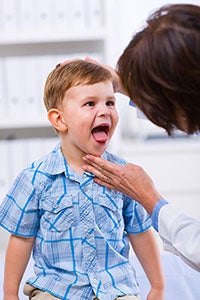Strep Throat

Having a sore throat could be the indicator of several different illnesses and conditions, including a simple cold virus, postnasal drip, acid reflux or a mono infection. However, a painful sore throat paired with a fever over 100.4 degrees is likely strep throat, a common bacterial infection caused by the bacteria Streptococcus. Enlarged cervical lymph nodes are also a tell-tale sign of strep, and these symptoms are possible as well:
- Headache
- Lower stomach pain
- Fever
- Nausea, loss of appetite
- Rash
Most common in late fall and early spring, strep throat is a contagious illness that is passed from person to person via respiratory secretions (nose and mouth). If left untreated, strep can be contagious in about 50 percent of patients for as long as a month. However, if treated with antibiotics, most strep patients are only contagious for about 48 hours.
It is important to see your doctor if you suspect you are exhibiting the symptoms of strep throat. He or she will perform a rapid strep test, which will identify group A strep. If the rapid strep test is negative, your doctor will perform a throat culture to see if the illness is being caused by another type of strep bacteria. Antibiotics will most likely be prescribed by your doctor if either test result is positive.
The good news is that strep throat is typically self-limited and should resolve after about four to seven days, with or without antibiotics. However, antibiotics will help shorten the symptoms, prevent complications and reduce the spread of infection. The incubation period for strep throat is usually 24 to 48 hours.
Help protect yourself and the members of your family by doing the following:
- Avoid close contact with people who are sick
- Wash hands often with soap and warm water
- Avoid sharing drinks, food and utensils
Strep throat is most common in children age 5 to 15 years old, as school and daycare settings allow the bacteria to spread easily. Someone who is immunocompromised is also at a greater risk for strep.